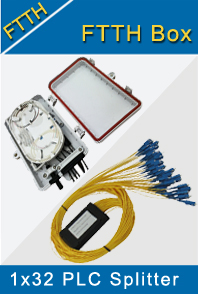-

- Sopto Home
-

- Special Topic
-

- FTTH Knowledge
-

- FTTH PON Splitting Ratio and Level
FTTH Knowledge
- Solving the FTTH Rollout Problem in Multiple Dwelling Units
- WDM PON Introduction FAQ
- A Simple Overview of Optical Power Meter
- ODN is based on PON FTTH Optical Cable Network of the Device
- Using an OTDR to be an Expert in Fiber Link Testing
- How FTTH Broadband Works?
- Connections among Fiber Terminal Boxes & Patch Cables & Pigtails
- Easy to Install a Fiber Terminal Box
- What is Arrayed Waveguide Grating?
SOPTO Special Topic
Certificate



Guarantee
Except products belongs to Bargain Shop section, all products are warranted by SOPTO only to purchasers for resale or for use in business or original equipment manufacturer, against defects in workmanship or materials under normal use (consumables, normal tear and wear excluded) for one year after date of purchase from SOPTO, unless otherwise stated...
Return Policies
Defective products will be accepted for exchange, at our discretion, within 14 days from receipt. Buyer might be requested to return the defective products to SOPTO for verification or authorized service location, as SOPTO designated, shipping costs prepaid. .....
Applications

Sopto supply the best FTTH solutions for your network!
SOPTO Products
- Fiber Optic Transceiver Module
- High Speed Cable
- Fiber Optical Cable
- Fiber Optical Patch Cords
- Splitter CWDM DWDM
- PON Solution
- FTTH Box ODF Closure
- PCI-E Network Card
- Network Cables
- Fiber Optical Adapter
- Fiber Optical Attenuator
- Fiber Media Converter
- PDH Multiplexers
- Protocol Converter
- Digital Video Multiplexer
- Fiber Optical Tools
- Compatible
Related Products
Performance Feature
FTTH Knowledge
Recommended

FTTH PON Splitting Ratio and Level
As the diagram described, consisting of an Optical Line Terminal (OLT) that is located in the Central Office (CO), the optical network with the optical power splitter and finally, the Optical Network Unit (ONU) as the Customer Premises Equipment (CPE). During the deployment of fiber to the home passive optical network (FTTH-PON), usually, we will face some physical access network design problems.
.png)
A Common PON Splitting Level Application
Splitting Ratio Principle and Solution
Optical splitter, also known as beam splitter, is one kind of integrated waveguide optical power distribution device based on a quartz substrate. A fiber splitter is one of the most important passive components in the whole FTTH network system. There are two types of splitters in our current FTTH application, their splitting ratio principle are as following:
- FBT SPLITTER makes two (two or more) fibers removed the coating layer gather in a certain way, stretched to both sides under the heating zone at the same time, form a double cone’s special waveguide structure finally for getting a different splitting ratio via controlling length of the fiber torsion angle and stretch.
- PLC SPLITTER is a micro-optical element using photolithographic techniques to form optical waveguide at medium or semiconductor substrate for realizing branch distribution function.
.png)
FTTH PON Single Splitting application
Based on our EPON/GPON project experience, two main splitting ratio solutions as following:
- When the splitting ratio is 1:32, your current network can receive qualified fiber optic signal in 20Km.
- If your distance between OLT and ONU is small, like in 5Km, you can also consider about 1:64.
Splitting Level
PON is a point-to-multipoint fiber optical network with no active elements in the signal’s path. It consists of a single, shared optical fiber connecting a service provider’s central office (CO) to a passive splitter, which can accommodate multiple optical connections with customers.
The PON splitting may be achieved by single splitting or by multiple/complex splitting (two-level) distributed splitting. The splitter of single splitting demultiplexes a downstream signal into, for example, 32 subscriber streams. Accordingly, the PON access network with single splitting forms a double-star topology with the first star at the CO and the second star at the splitter.
- Single splitting is, between the OLT to ONU only existed a single splitter.
- Two-level Splitting is, between the OLT to ONU existed two splitters in series.
- Multi-level splitting is, between the OLT to ONU existed multiple splitters in series
.png)
FTTH PON Two-level Splitting Application
The Single Splitting solution is usually used in crowded city center or town areas, in order to reduce cost and easy to maintain the optical distributed network (ODN) nodes.
In the other hand, Two-level and Multi-level Splitting solution is used in curb or village places, to cover widely ODN (optical distributed network) nodes, conserve resources and save the money.
For more info, please browse our website.



